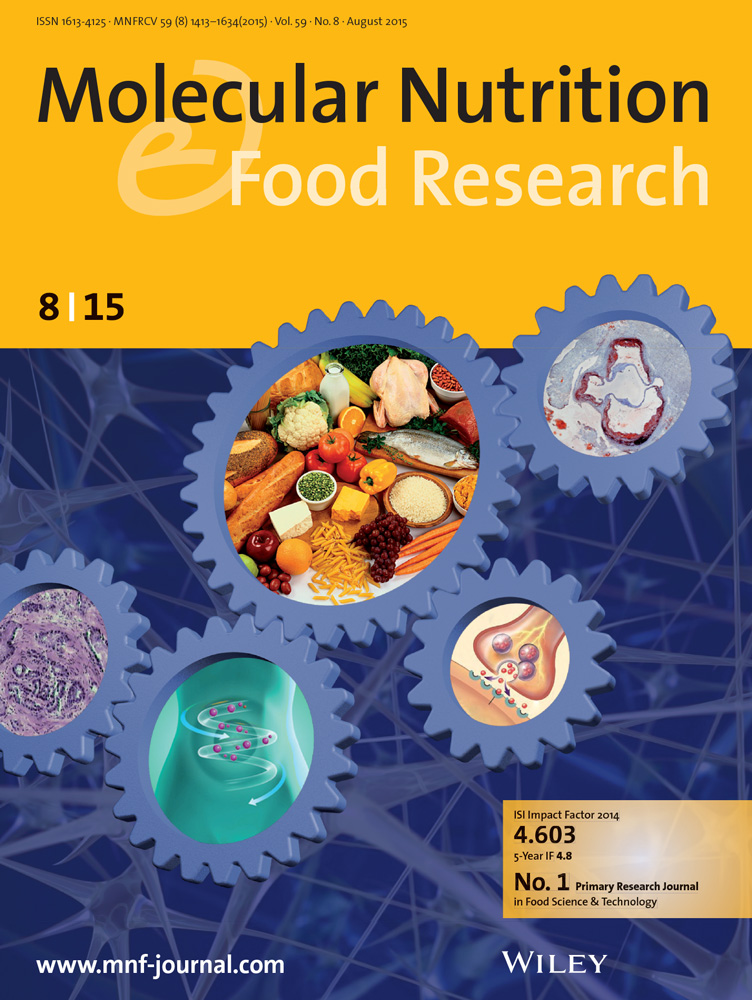蛋白质组学研究葡萄籽提取物对高脂肪饮食诱导的心脏代谢改变的缓解作用。
IF 4.2
2区 农林科学
Q1 FOOD SCIENCE & TECHNOLOGY
引用次数: 0
摘要
利用营养补充剂预防和治疗肥胖成为一种现实而有效的方法。本工作旨在利用蛋白质组学方法评估葡萄籽提取物(GSE)对大鼠心脏蛋白质组的潜在保护作用。利用肥胖啮齿动物模型,我们对标准、高脂肪饮食(HFD)和HFD+GSE组心脏样本进行了比较定量的蛋白质组学方法。LTQ OrbiTrap技术,随后是生物信息学工具,允许鉴定差异丰富蛋白(DAPs)。GSE通过恢复和/或增强部分DAPs,如乌头酸酶和丙酰辅酶a羧化酶,减轻了hfd诱导的能量代谢改变。此外,GSE通过过量的复合体I和复合体III来更新心肌细胞产生能量的能力。此外,GSE改善了肥胖患者的收缩功能,减轻了肌球蛋白和肌动蛋白等关键收缩蛋白过量引起的心肌病。本研究表明,在肥胖引起的代谢紊乱的情况下,GSE具有心脏保护作用。通过蛋白质组学方法,我们确定了参与能量代谢和收缩功能的关键DAPs,这些DAPs受到GSE的正调节。这些发现支持了GSE作为一种有前景的抗肥胖治疗剂的潜力。本文章由计算机程序翻译,如有差异,请以英文原文为准。
Proteomic Insights Into the Mitigating Effects of Grape Seed Extract on High-Fat Diet-Induced Cardiac Metabolic Alterations.
Prevention and treatment of obesity using nutritional supplements became a realistic and effective approach. The present work aims at the assessment of the potential protection afforded by grape seed extract (GSE) on the rat cardiac proteome using a proteomic approach. Using a rodent model of obesity, we performed a comparative quantitative proteomic approach of heart samples from standard, high-fat diet (HFD) and HFD+GSE groups. LTQ OrbiTrap technology, followed by bioinformatic tools, allowed the identification of differentially abundant proteins (DAPs). GSE alleviated the HFD-induced energy metabolism alteration by recovering and/or enhancing some DAPs, such as the aconitase and the propionyl-CoA carboxylase. Also, GSE renews the capacity of cardiomyocytes to produce energy by an overabundance of complex I and complex III. Additionally, GSE improved the contractile function and alleviated cardiomyopathy in obesity following an overabundance of key contractile proteins like myosins and actinin. This study demonstrates that GSE confers cardioprotective effects in the context of obesity-induced metabolic disturbances. Through a proteomic approach, we identified key DAPs involved in energy metabolism and contractile function that were positively modulated by GSE. These findings support the potential of GSE as a promising therapeutic anti-obesity agent.
求助全文
通过发布文献求助,成功后即可免费获取论文全文。
去求助
来源期刊

Molecular Nutrition & Food Research
工程技术-食品科技
CiteScore
8.70
自引率
1.90%
发文量
250
审稿时长
1.7 months
期刊介绍:
Molecular Nutrition & Food Research is a primary research journal devoted to health, safety and all aspects of molecular nutrition such as nutritional biochemistry, nutrigenomics and metabolomics aiming to link the information arising from related disciplines:
Bioactivity: Nutritional and medical effects of food constituents including bioavailability and kinetics.
Immunology: Understanding the interactions of food and the immune system.
Microbiology: Food spoilage, food pathogens, chemical and physical approaches of fermented foods and novel microbial processes.
Chemistry: Isolation and analysis of bioactive food ingredients while considering environmental aspects.
 求助内容:
求助内容: 应助结果提醒方式:
应助结果提醒方式:


